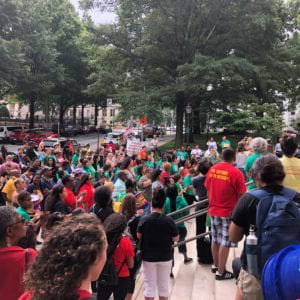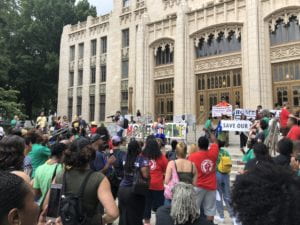
Taken Friday, July 21 during a protest at Atlanta’s City Hall organized by HFA member group Housing Justice League to call attention to development along the city’s BeltLine region, which has displaced low income residents without providing promised affordable housing units. HFA members from across the country took buses from the convention center where the assembly was being held to show support for their sister group.
It’s expected that Right to the City and, by extension, Homes For All, incorporate the principles outlined in CUNY professor David Harvey’s 2008 piece of the same name into their mission as well as their everyday work. Harvey writes about the capacity of city-dwellers to take control over the development of their neighborhoods to create a urban landscape influenced by the community’s needs.
This process, of course, is difficult to maneuver when your group is concerned with more than one city. After 2 months, it’s clear to me that Right to the City is committed to making what Harvey refers to as “democratic control over the production and utilization of the surplus” a reality nationwide. Yet going off of the definition of “Right to the City” I outlined above, there are, understandably, some limits on how successful the national team itself can be in helping institute this sort of structural shift on the ground as defined by Harvey compared to its member groups.
I’m pointing this out not to point out some fatal flaw on Right to the City’s behalf, but rather to point out how the organization upholds Harvey’s principles through its support of its member groups, particularly through its creation of spaces that help member groups envision and begin to participate in the future we’d like to see. This past week’s HFA Renter Power Member Assembly provides me with a number of examples.
In order to create urban landscapes that satisfy the needs of all residents, it’s vital that every individual (especially those whose voices have been systematically silenced by oppressive structures) has equal capacity to access spaces of change, to have their concerns heard and understood, and to practice the same for others in the space. For HFA, this involved offering free childcare to those who couldn’t afford to pay for a babysitter, making sure the conference space was ADA compliant and that all medical needs were addressed, and providing a language justice program that translated all aspects of the assembly (from featured speakers to breakout sessions) into English, Spanish, and Mandarin/Cantonese to allow all attendees to meaningfully participate in the language in which they were most comfortable speaking.
For me, this last one was crucial. The language justice support staff and volunteers worked tirelessly to support our Spanish and Chinese-speaking participants, and while the weekend didn’t come without its little road bumps, it was a nice way for me and others to get a taste of what more accessible spaces look like, and realize the privilege we had taken for granted as well as past missed opportunities for building community because we couldn’t understand one’s native tongue. Everyone who didn’t speak all three languages fluently (practically everyone) was required to use a listening system to ensure that everyone could speak in their native tongue and be understood by those who spoke other languages. I was able to hear strategy suggestions from tenants living in Boston’s Chinatown, anecdotes from latinx organizers in California, and more. It was the first time I had been a space where steps had been taken to put those who don’t primarily speak English on the same level of comfort as native speakers, where no one was made to feel like an outsider for having to rely on a headset.
Offering these services might not be the first thing that comes to mind when one thinks of organizing, but if we’re as committed to practicing direct democracy to reshape neighborhoods and production in a manner that benefits all, then we need to prioritize the removal of barriers which exclude those most exploited by the systems we seek to eradicate. It’s impossible for us to carry out work dictated by the wishes of those most affected by oppressive forces if they are unable to access organizing circles and vocalize their concerns By setting the tone for what equitable organizing spaces can look like, HFA made it possible for participants to reconsider how they could open up their local groups to make wider participation among diverse groups possible.

Another photo from the #Beltline4All action
In addition to helping members to rethink how their local spaces could better facilitate the centering of oppressed experiences, RTC/HFA helped introduce a national lens to the “right to the city” discourse that allows for the recognition of links between organizations across the country as contributors to a country-wide movement for land and housing justice. From the opening ceremony to the closing remarks, participants were reminded that tenants in the south have long been subject to higher and more widespread levels of discrimination, disempowerment, and disinvestment than that known by other regions, and that in order for all parts of the United States to achieve justice, it’s important that organizers look towards the work being carried out in the south to determine the direction of their own. Connections to the national level were also facilitated during sessions dedicated to developing HFA’s 10-year strategy, in which members broke out into seven regional groups (Northeast, Mid-Atlantic, South, Midwest, Mountain West, California, and Northwest) to determine what they felt needed to be prioritized in the national plan, later sharing these ideas with the other regions once everyone had reconvened.
The decisions to emphasize the importance of southern leadership to the movement and recognizing the links between struggles faced in the same region as well as those being fought in other regions helped take the work beyond local confines, encouraging people realize that their organizing is simultaneously complex and specific to their home base as well as part of a much larger nationwide campaign working towards equitable access to shelter. There’s a sort of understanding that groups must be embedded within national conversations just as much as they are the local one. We live in an increasingly interconnected world, and while the local lens is crucial to organizing, it is nearly impossible to imagine “democratic control over the production and utilization of surplus” within one locality without being held accountable to the millions of other local communities to which we are linked and feel the reverberated impact of any decisions decided on by members of the former. To do so would threaten the long-term success of all local justice projects.
In effect, it seems that RTC/HFA have helped foster a sense of translocal community among member organizations, where these groups and regions feel an obligation to uplift and do right by one another just as (theoretically) one resident would feel towards another member of their community under the traditional “right to the city” framework. Due to the nature of my work within RTC, I can’t say definitively whether the staff’s communication with groups one-on-one or through the transnational committees has positively impacted the member groups or helped further the “right to the city” principles. But going off of what I was able to witness at the assembly and comparing it with past experiences of being at the national level of other grassroots efforts, I felt that HFA created an environment that blurred the lines between local, regional, and national to help participants imagine democratic control on a much larger scale.

This is a really illuminating report that gives me a much better idea of what happens at the assemblies and the kinds of information one might be able to glean at them. Thank you for that! This reminds me of three separate, but sort of “rhyming” thoughts. One is something I’ve been saying all year particularly about the Lower East Side, which is that “community organizers need a community organizer.” And I think what you’re saying here is that RTC is trying to be the community organizer of community organizers, a place that serves as kind of a resource hub and pivot point around which all other local projects function more seamlessly. The second thing this makes me think of is Benedict Anderson’s book Imagined Communities (which other people’s posts, namely Kate’s, have made be think of too). Are you familiar with this text and his examination of how people in a colony distant from the “motherland” could still feel part of the motherland’s national project? It reminds me of how you describe RTC as “foster[ing] a sense of translocal community.” Anyway, worth a read! Finally, I can’t help but think about the general strikes that took place across the U.S. in the late-19th century, partly aided by groups like the International Workers of the World. How did these groups organize before the internet, before plane travel, before telephones? They did it largely through assemblies, pamphlets, newspapers, and books. They built intellectual communities. So my question: How does or can RTC build an intellectual community around its movement?